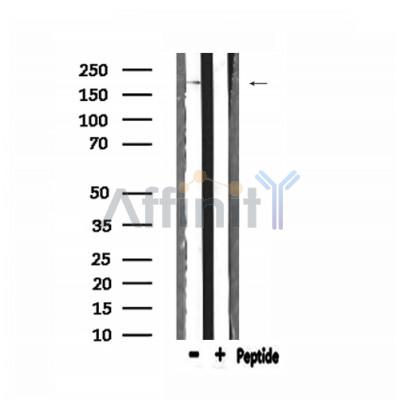BCOR Antibody - #DF3520
| Product: | BCOR Antibody |
| Catalog: | DF3520 |
| Description: | Rabbit polyclonal antibody to BCOR |
| Application: | WB IHC IF/ICC |
| Reactivity: | Human, Mouse |
| Prediction: | Pig, Bovine, Sheep, Dog |
| Mol.Wt.: | 192 KD; 192kD(Calculated). |
| Uniprot: | Q6W2J9 |
| RRID: | AB_2835740 |
Related Downloads
Protocols
Product Info
*The optimal dilutions should be determined by the end user. For optimal experimental results, antibody reuse is not recommended.
*Tips:
WB: For western blot detection of denatured protein samples. IHC: For immunohistochemical detection of paraffin sections (IHC-p) or frozen sections (IHC-f) of tissue samples. IF/ICC: For immunofluorescence detection of cell samples. ELISA(peptide): For ELISA detection of antigenic peptide.
Cite Format: Affinity Biosciences Cat# DF3520, RRID:AB_2835740.
Fold/Unfold
5830466J11Rik; 8430401K06Rik; ANOP 2; ANOP2; BCL 6 co repressor; BCL 6 corepressor; BCL 6 interacting corepressor; BCL-6 corepressor; BCL6 co repressor; BCL6 corepressor; BCL6 interacting corepressor; BCoR; BCOR_HUMAN; FLJ20285; FLJ38041; KIAA1575; MAA 2; MAA2; MCOPS 2; MCOPS2; MGC131961; MGC71031;
Immunogens
A synthesized peptide derived from human BCOR, corresponding to a region within the internal amino acids.
- Q6W2J9 BCOR_HUMAN:
- Protein BLAST With
- NCBI/
- ExPASy/
- Uniprot
MLSATPLYGNVHSWMNSERVRMCGASEDRKILVNDGDASKARLELREENPLNHNVVDASTAHRIDGLAALSMDRTGLIREGLRVPGNIVYSSLCGLGSEKGREAATSTLGGLGFSSERNPEMQFKPNTPETVEASAVSGKPPNGFSAIYKTPPGIQKSAVATAEALGLDRPASDKQSPLNINGASYLRLPWVNPYMEGATPAIYPFLDSPNKYSLNMYKALLPQQSYSLAQPLYSPVCTNGERFLYLPPPHYVGPHIPSSLASPMRLSTPSASPAIPPLVHCADKSLPWKMGVSPGNPVDSHAYPHIQNSKQPRVPSAKAVTSGLPGDTALLLPPSPRPSPRVHLPTQPAADTYSEFHKHYARISTSPSVALSKPYMTVSSEFPAARLSNGKYPKAPEGGEGAQPVPGHARKTAVQDRKDGSSPPLLEKQTVTKDVTDKPLDLSSKVVDVDASKADHMKKMAPTVLVHSRAGSGLVLSGSEIPKETLSPPGNGCAIYRSEIISTAPSSWVVPGPSPNEENNGKSMSLKNKALDWAIPQQRSSSCPRMGGTDAVITNVSGSVSSAGRPASASPAPNANADGTKTSRSSVETTPSVIQHVGQPPATPAKHSSSTSSKGAKASNPEPSFKANENGLPPSSIFLSPNEAFRSPPIPYPRSYLPYPAPEGIAVSPLSLHGKGPVYPHPVLLPNGSLFPGHLAPKPGLPYGLPTGRPEFVTYQDALGLGMVHPMLIPHTPIEITKEEKPERRSRSHERARYEDPTLRNRFSEILETSSTKLHPDVPTDKNLKPNPNWNQGKTVVKSDKLVYVDLLREEPDAKTDTNVSKPSFAAESVGQSAEPPKPSVEPALQQHRDFIALREELGRISDFHETYTFKQPVFTVSKDSVLAGTNKENLGLPVSTPFLEPPLGSDGPAVTFGKTQEDPKPFCVGSAPPSVDVTPTYTKDGADEAESNDGKVLKPKPSKLAKRIANSAGYVGDRFKCVTTELYADSSQLSREQRALQMEGLQEDSILCLPAAYCERAMMRFSELEMKEREGGHPATKDSEMCKFSPADWERLKGNQDKKPKSVTLEEAIAEQNESERCEYSVGNKHRDPFEAPEDKDLPVEKYFVERQPVSEPPADQVASDMPHSPTLRVDRKRKVSGDSSHTETTAEEVPEDPLLKAKRRRVSKDDWPEREMTNSSSNHLEDPHYSELTNLKVCIELTGLHPKKQRHLLHLRERWEQQVSAADGKPGRQSRKEVTQATQPEAIPQGTNITEEKPGRKRAEAKGNRSWSEESLKPSDNEQGLPVFSGSPPMKSLSSTSAGGKKQAQPSCAPASRPPAKQQKIKENQKTDVLCADEEEDCQAASLLQKYTDNSEKPSGKRLCKTKHLIPQESRRGLPLTGEYYVENADGKVTVRRFRKRPEPSSDYDLSPAKQEPKPFDRLQQLLPASQSTQLPCSSSPQETTQSRPMPPEARRLIVNKNAGETLLQRAARLGYEEVVLYCLENKICDVNHRDNAGYCALHEACARGWLNIVRHLLEYGADVNCSAQDGTRPLHDAVENDHLEIVRLLLSYGADPTLATYSGRTIMKMTHSELMEKFLTDYLNDLQGRNDDDASGTWDFYGSSVCEPDDESGYDVLANPPGPEDQDDDDDAYSDVFEFEFSETPLLPCYNIQVSVAQGPRNWLLLSDVLKKLKMSSRIFRCNFPNVEIVTIAEAEFYRQVSASLLFSCSKDLEAFNPESKELLDLVEFTNEIQTLLGSSVEWLHPSDLASDNYW
Predictions
Score>80(red) has high confidence and is suggested to be used for WB detection. *The prediction model is mainly based on the alignment of immunogen sequences, the results are for reference only, not as the basis of quality assurance.
High(score>80) Medium(80>score>50) Low(score<50) No confidence
Research Backgrounds
Transcriptional corepressor. May specifically inhibit gene expression when recruited to promoter regions by sequence-specific DNA-binding proteins such as BCL6 and MLLT3. This repression may be mediated at least in part by histone deacetylase activities which can associate with this corepressor. Involved in the repression of TFAP2A; impairs binding of BCL6 and KDM2B to TFAP2A promoter regions. Via repression of TFAP2A acts as a negative regulator of osteo-dentiogenic capacity in adult stem cells; the function implies inhibition of methylation on histone H3 'Lys-4' (H3K4me3) and 'Lys-36' (H3K36me2).
Nucleus.
Ubiquitously expressed.
Belongs to the BCOR family.
Restrictive clause
Affinity Biosciences tests all products strictly. Citations are provided as a resource for additional applications that have not been validated by Affinity Biosciences. Please choose the appropriate format for each application and consult Materials and Methods sections for additional details about the use of any product in these publications.
For Research Use Only.
Not for use in diagnostic or therapeutic procedures. Not for resale. Not for distribution without written consent. Affinity Biosciences will not be held responsible for patent infringement or other violations that may occur with the use of our products. Affinity Biosciences, Affinity Biosciences Logo and all other trademarks are the property of Affinity Biosciences LTD.
